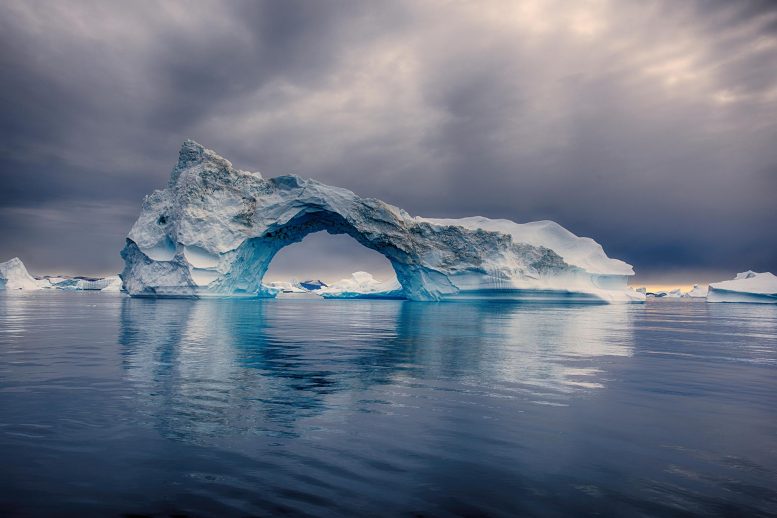
Greenland is losing ice seven times faster than in the 1990s and is tracking the Intergovernmental Panel on Climate Change’s high-end climate warming scenario, which would see 40 million more people exposed to coastal flooding by 2100.
A team of 96 polar scientists from 50 international organizations has produced the most complete picture of Greenland ice loss to date. The Ice Sheet Mass Balance Inter-comparison Exercise (IMBIE) Team combined 26 separate surveys to compute changes in the mass of Greenland’s ice sheet between 1992 and 2018. Altogether, data from 11 different satellite missions were used, including measurements of the ice sheet’s changing volume, flow, and gravity.
The findings, published today (December 10, 2019) in Nature, show that Greenland has lost 3.8 trillion metric tons of ice since 1992 — enough to push global sea levels up by 10.6 millimeters. The rate of ice loss has risen from 33 billion metric tons per year in the 1990s to 254 billion metric tons per year in the last decade — a seven-fold increase within three decades.
Greenland is losing ice seven times faster than in the 1990s and is tracking the Intergovernmental Panel on Climate Change’s high-end climate warming scenario, according to new research published in the journal Nature by an international team of polar scientists co-led by Professor Andrew Shepherd Leeds’ School of Earth and Environment.
The assessment, led by Professor Andrew Shepherd at the University of Leeds and Dr. Erik Ivins at NASA’s Jet Propulsion Laboratory in California, was supported by the European Space Agency (ESA) and the US National Aeronautics and Space Administration (NASA).
In 2013, the Intergovernmental Panel on Climate Change (IPCC) predicted that global sea levels will rise by 60 centimeters by 2100, putting 360 million people at risk of annual coastal flooding. But this new study shows that Greenland’s ice losses are rising faster than expected and are instead tracking the IPCC’s high-end climate warming scenario, which predicts 7 centimeters more.
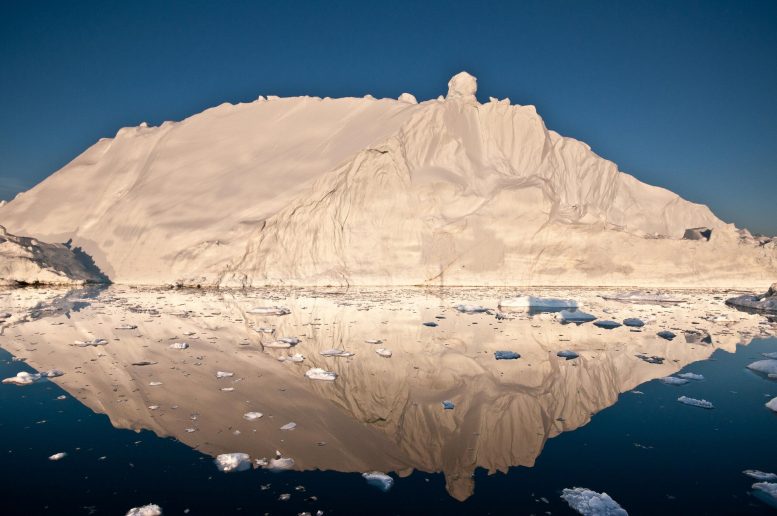
The midnight sun casts a golden glow on an iceberg and its reflection in Disko Bay, Greenland. Much of Greenland’s annual mass loss occurs through calving of icebergs such as this. Credit: Ian Joughin, University of Washington
Professor Shepherd said: “As a rule of thumb, for every centimeter rise in global sea level another six million people are exposed to coastal flooding around the planet.”
“On current trends, Greenland ice melting will cause 100 million people to be flooded each year by the end of the century, so 400 million in total due to all sea level rise.”
“These are not unlikely events or small impacts; they are happening and will be devastating for coastal communities.”
The team also used regional climate models to show that half of the ice losses were due to surface melting as air temperatures have risen. The other half has been due to increased glacier flow, triggered by rising ocean temperatures.
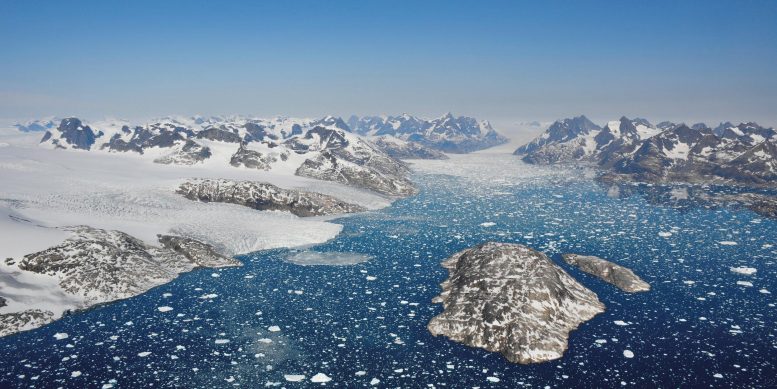
Outlet glaciers calving icebergs into the waters of Mogens Heinesen Fjord, Southwest Greenland. Credit: Benoit Lecavalier
Ice losses peaked at 335 billion metric tons per year in 2011 — ten times the rate of the 1990s — during a period of intense surface melting. Although the rate of ice loss dropped to an average 238 billion metric tons per year since then, this remains seven times higher and does not include all of 2019, which could set a new high due to widespread summer melting.
Dr. Ivins said: “Satellite observations of polar ice are essential for monitoring and predicting how climate change could affect ice losses and sea level rise”.
“While computer simulation allows us to make projections from climate change scenarios, the satellite measurements provide prima facie, rather irrefutable, evidence.”
“Our project is a great example of the importance of international collaboration to tackle problems that are global in scale.”
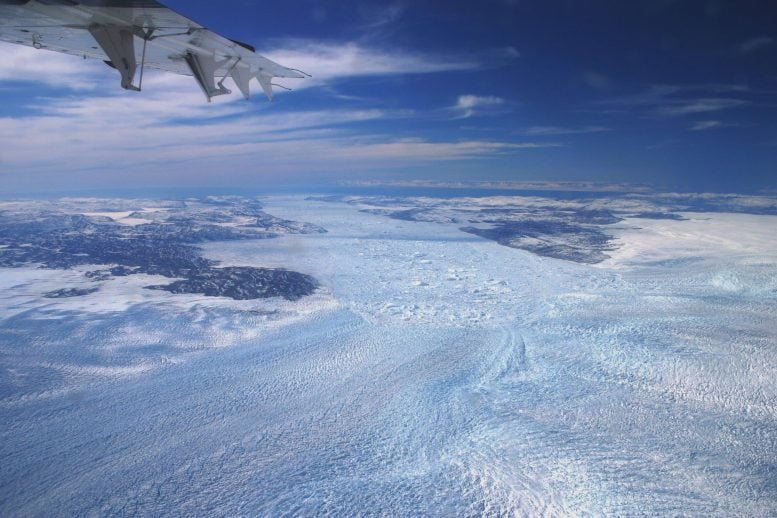
Outlet glaciers calving icebergs into the waters of Mogens Heinesen Fjord, Southwest Greenland. Credit: Benoit Lecavalier
Guðfinna Aðalgeirsdóttir, Professor of Glaciology at the University of Iceland and lead author of the Intergovernmental Panel on Climate Change’s sixth assessment report, who was not involved in the study, said:
“The IMBIE Team’s reconciled estimate of Greenland ice loss is timely for the IPCC. Their satellite observations show that both melting and ice discharge from Greenland have increased since observations started.”
“The ice caps in Iceland had a similar reduction in ice loss in the last two years of their record, but this last summer was very warm here and resulted in a higher loss. I would expect a similar increase in Greenland mass loss for 2019.”
“It is very important to keep monitoring the big ice sheets to know how much they raise sea level every year.”
Reference: “Mass balance of the Greenland Ice Sheet from 1992 to 2018” by The IMBIE Team 9 Andrew Shepherd, Erik Ivins, Eric Rignot, Ben Smith, Michiel van den Broeke, Isabella Velicogna, Pippa Whitehouse, Kate Briggs, Ian Joughin, Gerhard Krinner, Sophie Nowicki, Tony Payne, Ted Scambos, Nicole Schlegel, A Geruo, Cécile Agosta, Andreas Ahlstrøm, Greg Babonis, Valentina R. Barletta, Anders A. Bjørk, Alejandro Blazquez, Jennifer Bonin, William Colgan, Beata Csatho, Richard Cullather, Marcus E. Engdahl, Denis Felikson, Xavier Fettweis, Rene Forsberg, Anna E. Hogg, Hubert Gallee, Alex Gardner, Lin Gilbert, Noel Gourmelen, Andreas Groh, Brian Gunter, Edward Hanna, Christopher Harig, Veit Helm, Alexander Horvath, Martin Horwath, Shfaqat Khan, Kristian K. Kjeldsen, Hannes Konrad, Peter L. Langen, Benoit Lecavalier, Bryant Loomis, Scott Luthcke, Malcolm McMillan, Daniele Melini, Sebastian Mernild, Yara Mohajerani, Philip Moore, Ruth Mottram, Jeremie Mouginot, Gorka Moyano, Alan Muir, Thomas Nagler, Grace Nield, Johan Nilsson, Brice Noël, Ines Otosaka, Mark E. Pattle, W. Richard Peltier, Nadège Pie, Roelof Rietbroek, Helmut Rott, Louise Sandberg Sørensen, Ingo Sasgen, Himanshu Save, Bernd Scheuchl, Ernst Schrama, Ludwig Schröder, Ki-Weon Seo, Sebastian B. Simonsen, Thomas Slater, Giorgio Spada, Tyler Sutterley, Matthieu Talpe, Lev Tarasov, Willem Jan van de Berg, Wouter van der Wal, Melchior van Wessem, Bramha Dutt Vishwakarma, David Wiese, David Wilton, Thomas Wagner, Bert Wouters and Jan Wuite), 10 December 2019, Nature.
DOI: 10.1038/s41586-019-1855-2

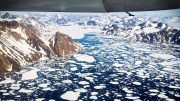
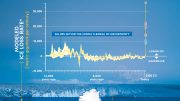
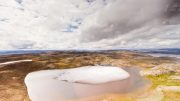
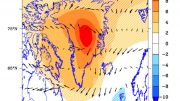
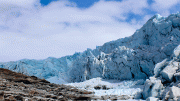


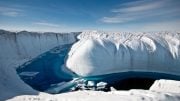
Keep in mind that Greenland is estimated to have 2,850 trillion metric tons of ice, so 3.8 trillion tons is only 0.13% of the total.
On 20 August 2020, scientists reported that the Greenland ice sheet lost a record amount of 532 billion metric tons of ice during 2019, surpassing the old record of 464 billion metric tons in 2012 and returning to high melt rates, and provide explanations for the reduced ice loss in 2017 and 2018.